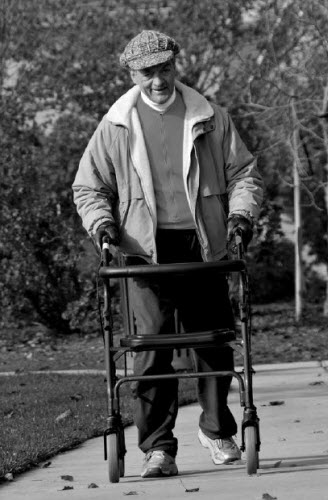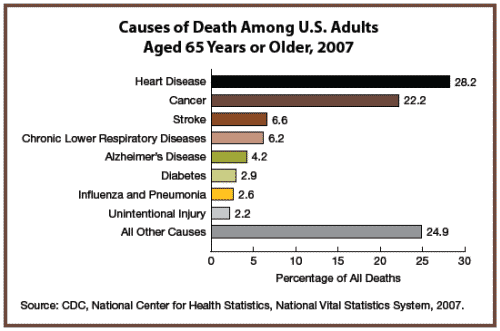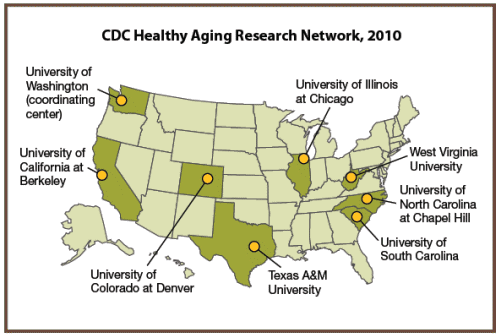Healthy Aging
Helping People To Live Long and Productive Lives and Enjoy a Good Quality Of Life
At A Glance 2011

On this Page
Implications of an Aging Society
By 2030, the number of U.S. adults aged 65 or older will more than double to about 71 million. The rapidly increasing number of older Americans has far-reaching implications for our nation's public health system and will place unprecedented demands on the provision of health care and aging-related services. Public health efforts to promote health and functional independence are critical strategies in helping older adults stay healthy. Research has shown that poor health does not have to be an inevitable consequence of aging. Older adults who practice healthy behaviors, take advantage of clinical preventive services, and continue to engage with family and friends are more likely to remain healthy, live independently, and incur fewer health-related costs. An essential component to keeping older adults healthy is preventing chronic diseases and reducing associated complications. About 80% of older adults have one chronic condition, and 50% have at least two. Infectious diseases (such as influenza and pneumococcal disease) and injuries also take a disproportionate toll on older adults. Efforts to identify strategies to prevent or reduce the risk of disease and injury and to widely apply effective interventions must be pursued.
Opportunities to Improve Older Adults' Health and Quality of Life
CDC works with states, communities, and other partners to support public health interventions that are designed to promote and preserve the health of older adults. Our priorities are to—
-
Promote healthy lifestyle behaviors to improve the health of older adults. Environmental and policy approaches that help older adults make healthy choices, such as getting regular physical activity and not smoking, could reduce the chronic disease burden in this population.
-
Increase the use of clinical preventive services. Only about 25% of adults aged 50–64 years are up-to-date on recommended immunizations and cancer screenings. Community strategies that increase the number of places where older adults can receive multiple preventive services could increase the use of these potentially lifesaving measures.
-
Address cognitive impairment. Cognitive impairment affects health and long-term care needs and presents major caregiving and financial challenges. Given the rapid aging of the U.S. population, a key public health goal is to assess and monitor the perceived burden of cognitive impairment in order to help states and communities develop policies and strategies to address this issue.
-
Address issues related to mental health. Mental health is essential to overall health and well-being. In recent years, public health efforts have focused on ways to better assess mental health among older adults. These efforts have led to the development of effective, community-based screening and treatment programs for people with depression.
-
Provide education on planning for serious illness. Public health and aging services professionals are in key positions to help people plan for care in case of serious or terminal illness.
CDC's Roles in Promoting Healthy Aging
The Healthy Aging Program at CDC conducts activities that contribute to a comprehensive approach to helping older adults live long, productive, and independent lives. It collaborates with other CDC programs and key external partners.
For example, the Healthy Aging Program works to—
Enhance the ability of states and communities to identify and implement effective strategies, policies, and programs to promote and protect the health of older adults. Since 2001, CDC has supported the Healthy Aging Research Network, a consortium of Prevention Research Centers at academic institutions around the country working to better understand the determinants of healthy aging, identify interventions that promote healthy aging, and help translate research into sustainable, community-based programs.
With support from the Agency for Healthcare Research and Quality (AHRQ) and CDC's Healthy Communities Program, the Healthy Aging Research Network created the Environ-mental and Policy Change for Healthy Aging conference series. This online, interactive initiative uses presentations, webinars, and other resources to help states and communities strengthen their ability to promote healthy aging (available at http://www.prc-han.org).
In addition, CDC provides three online, interactive data tools that present information and resources in a user-friendly format for public health and aging services professionals, journalists, researchers, and the public (http://www.cdc.gov/aging). These tools are based on publications that examine different health issues among older adults. The State of Aging and Health in America presents data and program resources on a variety of health topics for adults aged 65 years or older. The State of Mental Health and Aging in America focuses on key indicators of mental health for adults aged 50 years or older, including three evidence-based programs that communities can use to address depression in older adults.
Promoting Preventive Services for Adults 50–64: Community and Clinical Partnerships identifies a core set of recommended preventive services, provides indicators and data to monitor their use, and describes successful strategies to enhance their delivery.
The Healthy Aging Program also received a multiyear grant from CDC's Office of Public Health Preparedness and Response to improve the care of vulnerable older adults during disasters or emergencies. This project is being conducted with CDC's Public Health Law Program and will result in a new resource guide and online tool kit for local, state, territorial, and tribal jurisdictions. This guide will provide information on how to identify and protect older adults with chronic diseases, disabilities, or other conditions that make them vulnerable during disasters.
Expand efforts to integrate public health and aging services and enhance outreach for health promotion and disease prevention for older adults. CDC works to integrate public health's expertise in research, health tracking, and prevention with the experience and reach of the aging services network. Through the National Association of Chronic Disease Directors, CDC funds SENIOR (State-based Examples of Network Innovation, Opportunity, and Replication) grants in states to help health departments work more closely with their aging network colleagues. CDC also conducted a pilot workshop for the Massachusetts Department of Public Health in 2010 as part of its efforts to educate public health and aging services professionals on issues related to advance care planning. CDC is currently developing an online course on how to plan for serious illness care, which will be available to people who serve in public health and aging services networks across the country.
Promote health and preserve health-related quality of life for older adults within health care and other systems. CDC has developed a draft action guide for implementing SPARC (Sickness Prevention Achieved through Regional Collaboration), a program that has proven effective in increasing the use of preventive services among older adults. This action guide is for public health practitioners, clinicians, and policy makers and is being pilot-tested by a local medical society as a way to increase the delivery of preventive services to residents aged 50 years or older.
Healthy Brain Initiative
In 2007, CDC and the Alzheimer's Association released The Healthy Brain Initiative: A National Public Health Road Map to Maintaining Cognitive Health (http://www.cdc.gov/aging/healthybrain/roadmap.htm). One of the report's recommendations is to assess and monitor the effect of cognitive impairment at the state level. In response, CDC supported the development of new survey questions on cognitive impairment for the Behavioral Risk Factor Surveillance System (BRFSS). With data from five states that used the new questions in 2009, CDC is developing publications to educate public health professionals, policy makers, and other stakeholders about the importance of addressing cognitive impairment as a public health problem. These publications also can serve as models for how BRFSS data can be used. For 2011, a total of 19 states have been funded to include the new questions in their BRFSS surveys.
Future Directions
CDC and AARP are collaborating on an initiative to identify and promote community policies that can increase adults' use of clinical preventive services. As part of this initiative, a series of action briefs and a strategic plan are being developed to help implement the policies or strategies that stakeholders have identified as having the greatest potential to bring about measurable benefits in the next 3 years.
CDC partnered with the Administration on Aging, the AHRQ, the Centers for Medicare & Medicaid Services, and eight nonfederal partners to develop a report to draw attention to the use of clinical preventive services among adults aged 65 years or older. Enhancing Use of Clinical Preventive Services Among Older Adults: Closing the Gap, released in 2011, provides self-reported data to highlight gaps in the use of clinical preventive services and opportunities for increasing their use, particularly among the underserved. The report also features activities, interventions, and policies related to community actions that can increase access to and use of services. CDC's Healthy Aging Program will work with partners to ensure broad dissemination of the findings and activities described in this report.
In addition, CDC has funded the University of Washington as a member of the Healthy Aging Research Network to conduct a 3-year project examining the effects of dementia on other chronic diseases, including how it affects health outcomes such as a person's ability to function, quality of life, and length of lifespan. The project supports the U.S. Department of Health and Human Services' strategic framework for addressing multiple chronic conditions.
CDC also is working with the Center for Practical Bioethics and other partners to develop eLearning modules (online training) for public health and aging services professionals to introduce the subject of advance care planning, offer tools and resources, and explore the roles they might play with clients and constituents in their communities.
Success Stories
Stepping Up to a More Walkable Hendersonville
Public Health Problem
 In the coming decades, the number of U.S. adults aged 65 years or older will continue to increase, reaching 71 million people by 2030. This dramatic shift in the country's population will have significant implications for our communities and the decisions that need to be made about services and infrastructure. One area that is especially important for older adults is pedestrian safety. As people get older, they can develop age-related problems such as arthritis, poor vision, and poor balance that make it harder to get around. Communities that are properly planned make it easier for all residents, especially older adults, to walk without the fear of falling or being hit by cars.
In the coming decades, the number of U.S. adults aged 65 years or older will continue to increase, reaching 71 million people by 2030. This dramatic shift in the country's population will have significant implications for our communities and the decisions that need to be made about services and infrastructure. One area that is especially important for older adults is pedestrian safety. As people get older, they can develop age-related problems such as arthritis, poor vision, and poor balance that make it harder to get around. Communities that are properly planned make it easier for all residents, especially older adults, to walk without the fear of falling or being hit by cars.
In the United States, 1 of 3 adults aged 65 years or older falls each year, and falls are the leading cause of injury-related death for this age group. People aged 70 or older have a higher rate of death from being hit by cars than any other age group, according to the Insurance Institute for Highway Safety.
All residents should be able to walk safely in their communities, whether for physical activity, enjoyment, or simply to get where they want to go. For older adults, being able to walk not only promotes physical and mental well-being, but it also helps them to stay more connected to their communities. Any actions taken to improve pedestrian safety for this group will automatically benefit all residents.
Taking Action
To address this public health concern, community leaders in Hendersonville, North Carolina, came together to implement a pilot program called Walk Wise, Drive Smart. The goal of the program is to make neighborhoods in Hendersonville and surrounding areas more pedestrian-friendly for older adults. Hendersonville is an ideal testing ground for this program because more than 30% of residents are aged 65 years or older.
Walk Wise, Drive Smart is supported in part by CDC's Healthy Aging Research Network (HAN), which is funded by CDC's Healthy Aging Program and is part of a network of Prevention Research Centers that work with community partners across the country. The program is led by the University of North Carolina Highway Safety Research Center, the City of Hendersonville, and the Council on Aging for Henderson County.
These organizations have a well-established partnership that includes more than 75 other organizations, such as a senior center, local hospitals, a transportation group, an environmental and conservation organization, the county health department, local YMCA and AARP affiliates, and the Area Agency on Aging. The program also is an integral part of the Henderson County Livable and Senior Friendly Community Initiative, which serves more than 100,000 people throughout the county, and it is supported by the local business community.
To plan the Walk Wise, Drive Smart program, officials assessed walking conditions in 10 Hendersonville neighborhoods. They collected information with the HAN Environmental Audit Tool and through a series of neighborhood meetings and interviews. The resulting data pointed to the need to provide walking programs for people at different levels of fitness and to improve pedestrian facilities (e.g., sidewalks, crosswalks, traffic signals) to reduce walking hazards for older adults. The data also indicated a need to change the driving habits of residents to get them to slow down and yield to pedestrians.
To build community awareness and support for pedestrian safety, program officials
-
Developed pedestrian safety plans.
-
Conducted walking audits of individual neighborhoods.
-
Established neighborhood walking routes.
-
Upgraded pedestrian facilities on walking routes in selected neighborhoods.
-
Developed walking maps and materials on how to walk and drive safely.
-
Installed outdoor benches at strategic locations.
One innovative feature of the Walk Wise, Drive Smart program is that it provides incentives (e.g., coupons for prize drawings) to courteous drivers (e.g., those who yield to pedestrians in crosswalks). The program also has an easy-to-use Web site that posts current information about program-sponsored walks, hikes, and presentations on pedestrian safety, as well as other walking-related events that are free and open to the public.
During its initial implementation phase, the program regularly collected community feedback through surveys and interviews. This information was used to ensure that the program was meeting residents' needs and interests.
Implications and Impact
Since the Walk Wise, Drive Smart program began in 2005, it has helped to educate city officials and residents in Hendersonville about pedestrian safety. It also has made it easier for city officials to plan and implement changes to the environment to improve local walkways and roadways.
For example, city officials focused on improving the safety and walkability of certain walking routes and designated them as "senior friendly." They modified traffic patterns in some neighborhoods to reduce speeding "drive-through" traffic. They also collected data to identify specific problems that could increase the risk of injury for walkers, and this information was used to promote policy changes.
The Walk Wise, Drive Smart program in Hendersonville demonstrates the power of city officials and informed citizens to work together to make policy and environmental changes to make it easier for all residents, especially older adults, to walk safely in their communities. Residents embraced the value of walking and created many new opportunities for people of all ages and abilities to participate.
This program can serve as a model for other small to midsize communities across the United States. More information about the Walk Wise, Drive Smart program is available online at http://www.walk-wise.org.
For more information please contact the
Centers for Disease Control and Prevention
National Center for Chronic Disease Prevention and Health Promotion
4770 Buford Highway NE, Mail Stop K-38, Atlanta, GA 30341-3717
Telephone: 800-CDC-INFO (232-4636) • TTY: 888-232-6348
E-mail: cdcinfo@cdc.gov • Web:
http://www.cdc.gov/aging
Contact Us:
- Centers for Disease Control and Prevention
National Center for Chronic Disease Prevention and Health Promotion (NCCDPHP)
4770 Buford Hwy, NE
MS K-40
Atlanta, GA 30341-3717 - 800-CDC-INFO
(800-232-4636)
TTY: (888) 232-6348
8am-8pm ET
Monday-Friday
Closed Holidays - Contact NCCDPHP






